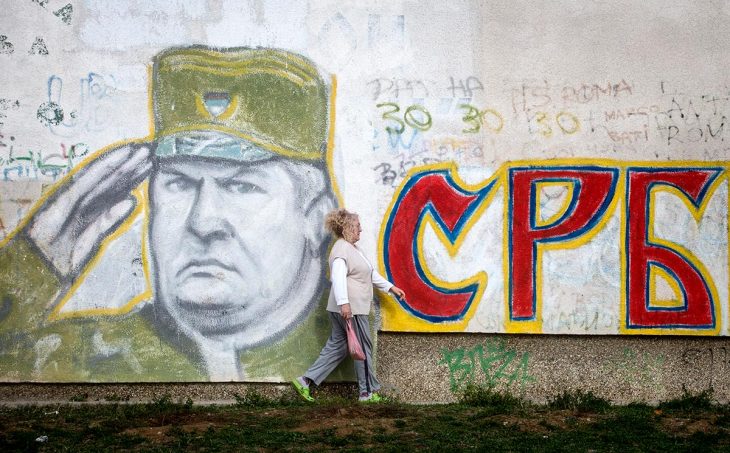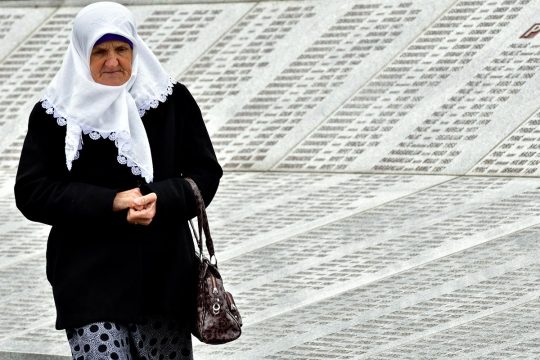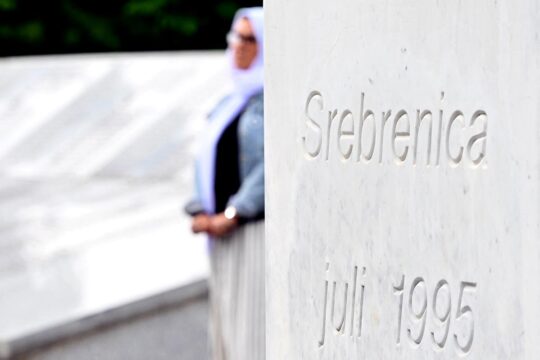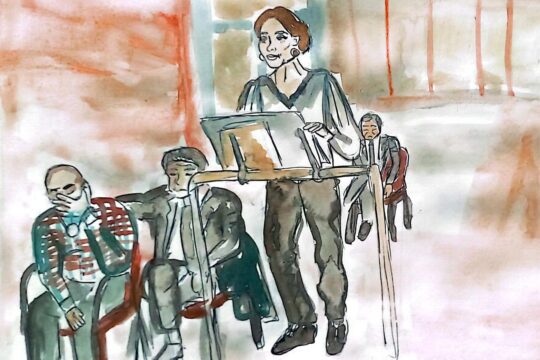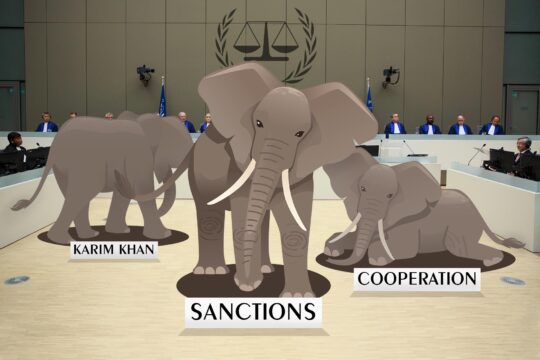Even 25 years after the war, Bosnia and Herzegovina (Bosnia) is a divided society, in which each of three major ethnic groups (Bosnian Serbs, Bosniaks and Bosnian Croats) cherish their own “version of truth” about war. The problem with this is that there is no “Serbian”, or “Bosniak”, or “Croatian” side of the story and there cannot be three “truths”.
Historical truth is only one river, regardless of how many influents it has. In every war, you can find only two sides of unequal positions – victim and war criminal, victims and organizers of genocide, defenders and attackers, conqueror and a threatened population, aggressor state and a threatened community. Everything else is historical sfumato, which should be carefully addressed.
Another problem with the “three truths” approach is that each “story” can rightfully claim its superiority over the other two – making catharsis, dealing with the past and reconciliation impossible, or at least unnecessary business. Attitude according to which the 1992-1995 conflict in Bosnia was “civil war” with three rightful “sides” among which one side planned and committed genocide is an impossible logic which ties the future of Bosnia firmly to the past, with a Gordian knot.
And this is precisely where the Bosnian society is right now. Jammed in the frozen conflict and unjust peace with no demilitarization, no denazification-like process, no significant refugee return, no accountability for politics and states that have inflicted mass extermination and genocide upon their neighbors and countrymen.
What “civil war”?
The trials at the International Criminal Tribunal for the former Yugoslavia (ICTY) in The Hague have been held far away from home and sites of atrocities, in foreign language and without sanctioned obligations to respect its decisions or to learn them in schools and through public media. By the time ICTY decisions drop on Bosnian soil they are devoured by the political forces that have sparked war and genocide and yet remained unpunished, unforbidden and fully functional. Thus, war criminals became heroes, and concentration camps became sites of a glorious past and of our victory.
If one can “righteously” choose among “three truths”, how he or she could ever be put in a position to question and condemn war strategy and ideology that were drivers for war and genocide? If the international community and courts are silent or not clear about the character of the war, or prefer a “civil war” approach, while Serbian politics officially justify and glorify this conflict both as “civil” and rightful “defense-patriotic” war, how can a young Bosnian Serb question this? Can I ask the war generation of Bosnian Serbs the same question posed by generations of sons to their fathers: “What have you done during the Third Reich”?
Yes, I can. However, this will not evoke shame or guilt but pride or indifference among the majority of citizens in Serbia and in the Bosnian entity of Republika Srpska (RS). For this question to be worth asking, some authority must impose clear political accountability and punishment for war-politics and state that have led to genocide. This question could work after the capitulation of the Third Reich, years of demilitarization and denazification, after Nuremberg and decades of other trials held in German towns, in German language, in front of German people. Even then, it took almost 25 years for the “Warschauer Kniefall” [The 1970 “Warsaw genuflection” by West German Chancellor Willy Brandt towards the victims of the Warsaw Ghetto uprising], for a majority of Germans to hear about Auschwitz, and for a nation’s revolt against their Nazi past. Even then, these issues were still very sensitive and complex.
The Bosnian postwar structure, however, is not nearly as favorable for dealing with the past as German was, though war crimes against Jews and those against Bosniaks [Bosnian Muslims, Ndlr] share the similar ideological background.

A genocide over a few weeks?
Srebrenica is important because it is a giant hole in the story that strives to portrait the Bosnian war as merely “civil war”. The Bosnian war did have its aggressor states, first Serbia and then Croatia, which implemented their state politics and war strategies on the soil of an independent country. Srebrenica is a key to understanding the true character of the wars in former Yugoslavia.
Can a war crime of such magnitude be reduced to the few weeks of July 1995? Could Srebrenica have appeared out of nowhere? Only a malicious and ignorant observer could say that Srebrenica is “genocide out of negligence”, just a massive manslaughter out of the patriotic glee of a local military leader, perhaps the result of “centuries-old hatred”, or Huntington’s “clash of civilizations”.
Why, for international judges and mainstream politics, is genocide just this single campaign of killings during several weeks in July 1995 in Srebrenica while a far more systematic, logistically and politically better planned and executed campaign of terror from spring 1992 to the fall of 1993, which took lives of more than 15,000 and expelled more than 400,000 of Bosniak and Bosnian Croat civilians, on the entire area controlled by RS, is not? Between May and September 1992 only in Prijedor and three municipalities of Sana river valley RS government established 15 concentration camps, imprisoned around 40,000 civilians, organized executions of more than 5,600 civilians, hid bodies in 146 mass graves, and expelled half of the population, more than 120,000 citizens. Could this constitute a genocide?
“That, people, is a genocide!”
The UN Special Envoy Tadeusz Mazowiecki has indicated that war in Bosnia was genocidal in its nature from the very beginning, not just at the end. In his October 1992 report he stressed that “ethnic cleansing does not appear to be the result of war, but is primarily the goal of war”. He added that the primary goal of the conflict was to establish an ethnically homogeneous region under control of the self-proclaimed authorities of RS. Prominent historian Robert Donia argues that extermination of non-Serbs was the goal of Serb politicians from the beginning. The official formulation of that goal was presented on May 12, 1992, at the 16th session of the RS Assembly in Banja Luka, where RS President Radovan Karadžić outlined six strategic goals of Serbian politics in Bosnia and the chief commander of the Bosnian Serb (para)military Ratko Mladić made a significant remark: “I don't know how Mr. Krajišnik and Mr. Karadžić will explain [this] to the world. That, people, is a genocide!”
Political will and ideological preparation; a readiness of people to be silent and ignorant about extermination of their neighbors and fellow citizens; a highly organized and huge machinery to turn factories, cultural centers and schools into concentration camps; a motivation to dig hundreds of mass graves and transport thousands of corpses in secrecy; a plan for long-lasting hiding of traces: for genocide of such efficiency and successfulness, you need years (sometimes decades) and a political decision behind made of political interests and strategy of the state.
To reduce genocide to those few weeks and to that one city is to relativize and even trivialize crimes against humanity, to reward war criminals and war politics. It is an invitation for new crimes. Did the Holocaust take place only during 1944 and 1945, or did it culminate at the beginning of the war, when the policy of "final solution" was shaped, when the Third Reich was at the height of its power? Holocaust wasn’t shaped and executed in the fall of Nazi power. The genocide in Bosnia also began at the peak of Serbian military power in 1992. Srebrenica were just the finalization of what Serbian politics had started in Prijedor and Sarajevo in May 1992.
“Culturecide”, the most important element of the war against Bosnia
Genocide is targeting not only a population, but also their tradition, religion, social institutions, cultural and historical heritage. In Bosnia, genocide aimed not just to exterminate, but to discourage and prevent potential return and life. It targeted the remembrance and cultural memory. The specific, complex, inter-ethnic, inter-faith culture of the melting pot of Bosnia was attacked, only to emphasize to the absurd minor and non-existential identity differences. Is there a better way for the “awakening of national spirit” than a bloodshed?
To which extent history and culture were an important segment of the overall genocidal endeavor can be seen in the scope and intensity of the destruction of Bosnian cultural and historical heritage. Professor Andreas Riedlmayer testified before the ICTY that RS authorities destroyed or damaged more than half (985) of the total number of mosques (1706), and at least 270 Catholic churches and 23 monasteries in Bosnia, and that was done largely in the first nine months of the war. A Commander of the RS police in Prijedor, Simo Drljača, told the New York Times in August 1992: “With their mosques you must not just break the minarets. You’ve got to shake up foundations because that means they cannot build another. Do that, and they’ll want to go. They’ll leave by themselves.”
Not only religious buildings were targeted. At the beginning of the 44-month siege of the Bosnian capital city, in May 1992, Serb forces completely destroyed the building of the Oriental Institute in Sarajevo and its entire collection – over 200,000 documents of outstanding historical, literary and artistic value. In August 1992, Serb forces burned down between 80% and 90% of the entire fund of the Bosnian National Library and its building, a pearl of pseudo-Moorish architectural style from 19th century. Professor Riedlmayer points out that the destruction of the Bosnian library is the largest single deliberate book-burning event in modern history. More than 1.5 million books and 300 unique manuscripts were destroyed. This irreversible destruction of cultural heritage and history is “culturecide” – the most important element of the war against Bosnia.

A genocide politically rewarded
This war was attempt of rewriting of Bosnian history, which still lasts. “Where you find an urban pattern of destructions which is annihilation, bulldozing a monument, it’s like saying ‘well they were never there’. (…) By rewriting history, you are writing history without the others,” said professor Colin Kaiser in his testimony before the ICTY.
The RS has never had any political or cultural precedent or predecessor in the entire Bosnian history. But still it is there, paradoxically as a result of genocide and as part of a “peace project”. Thus, a new desirable history is needed. Instrumentalized by the Milošević’s regime, Bosnian Serbs have essentially fought a war against their own country, their own history, traditions and heritage, in an effort to legitimize the creation of RS.
The question remains: To what extent the genocide in Bosnia has gone politically unpunished? Or has it, perhaps, been politically rewarded? All Serbian war gains and achievements in Bosnia, including municipalities “cleansed” from non-Serbs, were suddenly legalized in the November 1995 in Dayton. The war frontlines became the administrative demarcation line of RS, which was allowed to retain its discriminatory name, war-time quasi-state constitution, political symbols and authorities. Later, convicted war criminals were political leaders of RS in the first post-war years. Today they are still role-models and heroes very present in the public and political life of Serbia and RS. The return of refugees was heavily obstructed and violently prevented. The return or rebuilding of their property was delayed as well as the rehabilitation of destroyed mosques and churches. Returnees could not be reinstituted on their previous jobs, especially in public administration and public companies. The RS authorities have “pan-Serbianized” official narratives, such as emblems of municipalities, holidays, names of streets, schools, etc. – a true simulacrum of ethno-monolithic public and political space reserved only to Serbs. All political and cultural consequences of the war and genocide were and still are legalized.
Denial, the final phase of the crime
When all this is apprehended, it is easier to understand the obsession of Serbian and RS political leaders to deny genocide. Once they don’t, their entire system of war gains would be in question. For more than two decades, genocide denial has been a political project and a state strategy financed by governments of Serbia and RS. Denial is the final phase of genocide, which should lead to oblivion and avoidance of any political or historical responsibility. And the Dayton peace architecture which ethnically divided the Bosnian society, people and election system is a perfect base for Serbian nationalists to successfully avoid facing the past – the perfect ground for continuing war policy by other means.
Western governments in particular have shown deep misunderstanding of the causes of the Yugoslav crisis, with strange perception about attackers and defenders. They named this conflict “civil war” or “war of hatred” very early, contrary to facts and elaborate reports from the field. Tadeusz Mazowiecki resigned from his position as UN Special Envoy on July 27, 1995, two weeks after the massacre in Srebrenica, disappointed by the unwillingness of the international community to defend the people of Bosnia. In his resignation letter he wrote: “(…) we are dealing with the struggle of a State, a member of the United Nations, for its survival and multi-ethnic character, and with the endeavor to protect principles of international order. One cannot speak about the protection of human rights with credibility when one is confronted with the lack of consistency and courage displayed by the international community and its leaders. The reality of the human rights situation today is illustrated by the tragedy of the people of Srebrenica and Žepa. (…) The very stability of international order and the principle of civilization is at stake over the question of Bosnia. I am not convinced that the turning point hoped for will happen and cannot continue to participate in the pretense of the protection of human rights.”
 SRĐAN ŠUŠNICA
SRĐAN ŠUŠNICA
Srđan Šušnica is a culture and religion studies researcher, a lawyer and a vocal advocate for transitional justice, postwar reconciliation and human rights. Before being forced to leave Banja Luka and Bosnia, he was a teaching assistant at the University of Zenica and a public sector auditor in Banja Luka.


